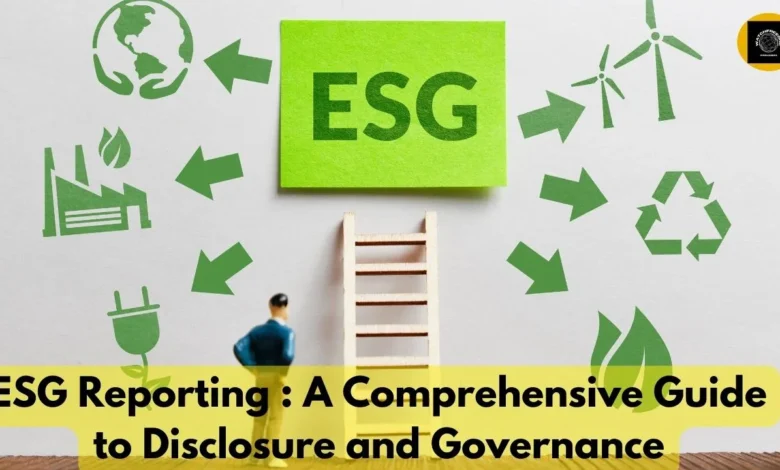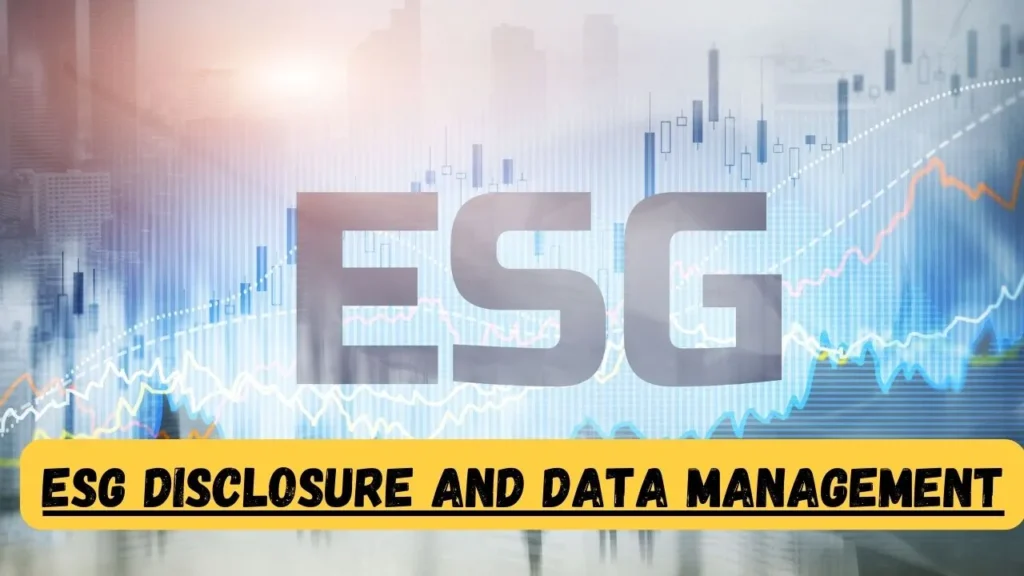ESG Reporting : A Comprehensive Guide to Disclosure and Governance

ESG Reporting : A Comprehensive Guide to Disclosure and Governance
ESG (Environmental, Social, and Governance) is a term that has been gaining momentum in the business world. It refers to a set of standards that companies can use to measure their environmental, social, and governance impact. The concept of ESG is closely linked to sustainability, and it is becoming increasingly important for companies to report on their ESG performance. In this article, I will explore the various frameworks and standards that exist for ESG reporting and explain why they are important.
One of the key drivers of ESG reporting is the demand from stakeholders for greater transparency and accountability. Investors, customers, and employees are increasingly interested in the social and environmental impact of the companies they work for or invest in. As a result, companies are under pressure to disclose more information about their ESG efforts. In response to this demand, a number of reporting frameworks and standards have emerged, which I will discuss in more detail in the following sections.
Key Takeaways
- ESG reporting is becoming increasingly important for companies as stakeholders demand greater transparency and accountability.
- There are numerous frameworks and standards for ESG reporting, including the EU Sustainability Reporting Directive, the Global Reporting Initiative, and the Sustainability Accounting Standards Board.
- ESG reporting can help companies improve their sustainability efforts, engage with stakeholders, and demonstrate their commitment to environmental, social, and governance issues.
Understanding ESG and Sustainability
As companies increasingly recognize the importance of environmental, social, and governance (ESG) factors in their operations, the need for a standardized framework for reporting on these issues has become more pressing. In this section, I will provide an overview of the evolution of ESG frameworks, the demand for ESG and sustainability reporting, and key ESG concepts and terminology.
Evolution of ESG Frameworks
Over the past few decades, there has been a growing recognition of the importance of ESG issues in business decision-making. As a result, various frameworks and standards have emerged to help companies report on these issues. One of the most widely recognized frameworks is the Global Reporting Initiative (GRI), which provides a comprehensive set of guidelines for sustainability reporting. Other frameworks include the Sustainability Accounting Standards Board (SASB), the Task Force on Climate-related Financial Disclosures (TCFD), and the United Nations Guiding Principles Reporting Framework.
In Europe, there has been a push towards more standardized sustainability reporting, with the introduction of the European Sustainability Reporting Standards (ESRS) and the Corporate Sustainability Reporting Directive (CSRD). These initiatives aim to improve the quality and comparability of sustainability reporting across the EU.
Demand for ESG and Sustainability
There is a growing demand from stakeholders, including investors, customers, and employees, for companies to disclose their ESG performance. This demand has been driven by a number of factors, including concerns about climate change, social justice issues, and corporate governance. In response, companies are increasingly adopting ESG strategies and reporting on their ESG performance.
Key ESG Concepts and Terminology
To effectively report on ESG issues, it is important to understand key concepts and terminology. Some of the most commonly used terms include:
- Environmental: Refers to issues related to climate change, resource depletion, pollution, and other environmental impacts.
- Social: Refers to issues related to labor practices, human rights, community engagement, and other social impacts.
- Governance: Refers to issues related to board structure, executive compensation, shareholder rights, and other governance issues.
Other important concepts include sustainability, supply chain, carbon emissions, and stakeholder engagement.
In conclusion, understanding ESG and sustainability is becoming increasingly important for companies seeking to improve their environmental and social impact, as well as their governance practices. By adopting standardized reporting frameworks and disclosing their ESG performance, companies can demonstrate their commitment to sustainability and meet the growing demand from stakeholders for greater transparency and accountability.
Global ESG Reporting Frameworks
As the demand for ESG reporting increases, several frameworks have emerged to help companies report on their sustainability efforts. In this section, I will discuss three of the most widely recognized global ESG reporting frameworks: Global Reporting Initiative (GRI), Sustainability Accounting Standards Board (SASB), and Climate Disclosure Standards Board (CDSB).
Global Reporting Initiative (GRI)
The Global Reporting Initiative (GRI) is a widely used framework for sustainability reporting. The GRI Standards provide a comprehensive set of indicators that companies can use to report on their ESG performance. The framework covers topics such as governance, human rights, labor practices, environmental impact, and social responsibility. The GRI Standards are widely recognized and used by companies around the world.
Sustainability Accounting Standards Board (SASB)
The Sustainability Accounting Standards Board (SASB) is another widely used global ESG reporting framework. The SASB Standards provide a set of industry-specific sustainability accounting standards that companies can use to report on their ESG performance. The framework covers topics such as environmental impact, social capital, human capital, and business model and innovation. The SASB Standards are designed to be industry-specific, which makes them more relevant and useful for companies operating in specific sectors.
Climate Disclosure Standards Board (CDSB)
The Climate Disclosure Standards Board (CDSB) is a framework that helps companies report on their climate-related financial risks and opportunities. The CDSB Framework provides a set of guidelines that companies can use to report on their carbon emissions, climate-related risks, and opportunities. The framework is widely recognized and used by companies around the world.
In conclusion, these global ESG reporting frameworks provide companies with a structured approach to reporting on their sustainability efforts. By using these frameworks, companies can ensure that they are reporting on the most relevant ESG issues and providing stakeholders with accurate and reliable information.
Integrated Reporting and Financial Standards
As companies increasingly recognize the importance of disclosing their environmental, social, and governance (ESG) performance, there is a growing need for standardized reporting frameworks. Integrated reporting is one such framework that aims to provide a holistic view of a company’s performance by integrating financial and non-financial information.
International Integrated Reporting Council (IIRC)
The International Integrated Reporting Council (IIRC) is a global coalition of regulators, investors, companies, and standard-setters that promotes integrated reporting. The IIRC’s framework encourages companies to report on how they create value over the short, medium, and long term, and how their strategy, governance, performance, and prospects contribute to sustainable development.
The IIRC’s framework is based on six capitals: financial, manufactured, intellectual, human, social and relationship, and natural. By reporting on all six capitals, companies can provide a more complete picture of their performance and demonstrate how they are creating value for all stakeholders.
International Financial Reporting Standards (IFRS)
International Financial Reporting Standards (IFRS) are a set of accounting standards developed by the International Accounting Standards Board (IASB). IFRS are designed to provide a common global language for business affairs so that company accounts are understandable and comparable across international boundaries.
IFRS are used by more than 100 countries, including the European Union, Australia, and Canada. The IFRS Foundation is responsible for the governance and oversight of the IASB, and it works to promote the adoption of IFRS around the world.
IFRS are primarily focused on financial reporting, but they also include some requirements for non-financial reporting. For example, IFRS 7 requires companies to disclose information about their financial instruments, including their exposure to credit risk, liquidity risk, and market risk.
Overall, integrated reporting and IFRS are two important frameworks that can help companies improve their sustainability reporting and provide more transparency to stakeholders. By using these frameworks, companies can better understand their ESG impacts and make more informed decisions about how to improve their sustainability performance.
EU Regulations and Directives
As a reporter covering ESG and sustainability issues, it is crucial to understand the various regulations and directives that govern corporate reporting in the European Union. In this section, I will discuss three important directives that companies must adhere to: the EU Taxonomy, the Non-Financial Reporting Directive (NFRD), and the Corporate Sustainability Reporting Directive (CSRD).
EU Taxonomy
The EU Taxonomy is a classification system that defines which economic activities can be considered sustainable. It was created to help investors and companies understand what qualifies as environmentally sustainable, and to encourage investment in sustainable activities. The taxonomy covers six environmental objectives: climate change mitigation, climate change adaptation, sustainable use and protection of water and marine resources, transition to a circular economy, pollution prevention and control, and protection and restoration of biodiversity and ecosystems.
Non-Financial Reporting Directive (NFRD)
The Non-Financial Reporting Directive (NFRD) requires large companies in the EU to disclose information on their environmental, social, and governance (ESG) policies and performance. The directive applies to companies with more than 500 employees, or with a turnover of over €40 million and a balance sheet total of over €20 million. Companies must report on a range of ESG issues, including greenhouse gas emissions, energy use, employee diversity, and anti-corruption measures. The NFRD is currently under review, with proposed changes that would expand its scope and require companies to report on additional ESG issues.
Corporate Sustainability Reporting Directive (CSRD)
The Corporate Sustainability Reporting Directive (CSRD) is a proposed update to the NFRD that would require all large companies in the EU to report on their sustainability performance using a standardized reporting framework. The CSRD would replace the NFRD and introduce new reporting requirements, including mandatory reporting on social and human rights issues, and the use of digital reporting formats. The directive is currently being negotiated by the European Parliament and Council, with the aim of being adopted by 2022.
In conclusion, the EU Taxonomy, NFRD, and CSRD are important regulations and directives that companies must comply with in order to report on their ESG performance. These frameworks provide a standardized approach to ESG reporting, which can help investors and stakeholders make informed decisions about a company’s sustainability efforts.
Corporate Governance and Reporting
As companies seek to improve their sustainability performance, corporate governance and reporting play a critical role in ensuring accountability and transparency. Effective corporate governance helps companies to manage risks and create value for stakeholders, while reporting provides stakeholders with the information they need to make informed decisions.
Corporate Reporting Requirements
Corporate reporting requirements vary by jurisdiction, but most require companies to disclose their financial and non-financial performance. In the EU, for example, the Non-Financial Reporting Directive (NFRD) requires large companies to report on their environmental, social, and governance (ESG) performance. The EU Taxonomy also provides a framework for companies to report on their sustainability activities and align them with the EU’s climate and environmental objectives.
In the UK, companies are required to report on their greenhouse gas emissions and energy use through the Streamlined Energy and Carbon Reporting (SECR) framework. The SECR framework requires companies to provide information on their energy use, greenhouse gas emissions, and energy efficiency measures in their annual reports.
Streamlined Energy and Carbon Reporting (SECR)
SECR is a mandatory reporting framework that requires large UK companies to report on their energy use, greenhouse gas emissions, and energy efficiency measures. The framework aims to encourage companies to reduce their energy use and emissions and improve their energy efficiency.
SECR reporting is required for all large UK companies that meet two or more of the following criteria: turnover of over £36 million, balance sheet total of over £18 million, or more than 250 employees. Companies are required to report on their energy use, greenhouse gas emissions, and energy efficiency measures in their annual reports.
In conclusion, effective corporate governance and reporting are critical components of a company’s sustainability strategy. By providing stakeholders with the information they need to make informed decisions, companies can build trust, manage risks, and create value for their stakeholders. The SECR framework and other reporting requirements provide companies with a framework for reporting on their sustainability performance and improving their sustainability practices.
ESG Disclosure and Data Management
As the demand for ESG reporting continues to grow, companies are faced with the challenge of managing and disclosing vast amounts of ESG data. In this section, I will discuss two important frameworks that can help companies effectively disclose and manage their ESG data: the Task Force on Climate-Related Financial Disclosures (TCFD) and the United Nations Guiding Principles Reporting Framework.

Task Force on Climate-Related Financial Disclosures (TCFD)
In 2015, the Financial Stability Board set up the TCFD to create recommendations on how companies should disclose financial risks and opportunities related to climate change. The TCFD offers a structured way to report climate-related information, covering areas like governance, strategy, risk management, and metrics and targets. Recognized as a leading standard for climate-related financial disclosures, the TCFD framework has the backing of over 1,000 organizations worldwide.
By using the TCFD framework, companies can improve their understanding of climate-related risks and opportunities and communicate this information to stakeholders in a clear and consistent manner. This can help companies to better manage their ESG data and improve their overall ESG performance.
United Nations Guiding Principles Reporting Framework
The United Nations Guiding Principles Reporting Framework provides a comprehensive framework for reporting on a company’s human rights performance. The framework is based on the United Nations Guiding Principles on Business and Human Rights and provides guidance on how companies can meet their responsibility to respect human rights.
The framework consists of three parts: the Reporting Framework, the Implementation Guidance, and the Indicator Library. The Reporting Framework provides a structure for reporting on a company’s human rights performance, while the Implementation Guidance provides guidance on how to implement the framework. The Indicator Library provides a set of indicators that companies can use to measure their human rights performance.
By using the United Nations Guiding Principles Reporting Framework, companies can improve their understanding of human rights issues and communicate this information to stakeholders in a clear and consistent manner. This can help companies to better manage their ESG data and improve their overall ESG performance.
In conclusion, effective ESG disclosure and data management is critical for companies to improve their ESG performance and meet the growing demand for ESG reporting. By using frameworks such as the TCFD and the United Nations Guiding Principles Reporting Framework, companies can effectively manage their ESG data and communicate this information to stakeholders in a clear and consistent manner.
Stakeholder Engagement and Reporting Strategies
Voluntary vs Mandatory Reporting
When it comes to reporting on Environmental, Social, and Governance (ESG) factors, companies have the option to voluntarily disclose their performance or be required to do so by regulatory bodies. Voluntary reporting allows companies to choose which metrics they want to report, while mandatory reporting requires companies to disclose specific ESG metrics.
Voluntary reporting can be beneficial for companies that want to demonstrate their commitment to sustainability and attract socially responsible investors. However, it may not provide a comprehensive picture of the company’s ESG performance, as companies may choose to report only on positive metrics and ignore negative ones.
Mandatory reporting, on the other hand, can provide a more complete view of a company’s ESG performance, as it requires companies to report on specific metrics. The downside is that it can be costly and time-consuming for companies to comply with mandatory reporting requirements.
Reporting to Stakeholders
Stakeholder engagement is a critical component of ESG reporting. Stakeholders include investors, customers, employees, suppliers, and the community. Companies need to identify their stakeholders and understand their expectations and concerns regarding ESG issues.
ESG reporting should be tailored to the needs and interests of different stakeholder groups. For example, investors may be interested in a company’s carbon emissions and climate-related risks, while customers may be interested in the company’s social impact and supply chain practices.
Companies should also consider the format and frequency of their ESG reporting. Some stakeholders may prefer a detailed annual report, while others may prefer a brief summary or an interactive dashboard.
In summary, companies need to develop a reporting strategy that aligns with their stakeholders’ expectations and provides a comprehensive view of their ESG performance. Whether companies choose to report voluntarily or are required to do so, they should prioritize stakeholder engagement and tailor their reporting to meet their stakeholders’ needs.
ESG Performance Metrics and Scores
Developing ESG Metrics
When it comes to measuring ESG (Environmental, Social, and Governance) performance, companies are faced with the challenge of developing metrics that accurately reflect their sustainability efforts. Developing ESG metrics requires a thorough understanding of the company’s sustainability goals and the impact of its operations on the environment, society, and governance.
ESG metrics can be categorized into three main areas: environmental, social, and governance. Environmental metrics focus on a company’s impact on the environment, such as greenhouse gas emissions, water consumption, and waste management. Social metrics measure a company’s impact on society, such as employee diversity, labor practices, and community engagement. Governance metrics assess the effectiveness of a company’s leadership and management practices, including board diversity, executive compensation, and shareholder rights.
To develop effective ESG metrics, companies need to engage with stakeholders, including investors, customers, employees, and community members. By involving stakeholders in the metric development process, companies can ensure that their sustainability efforts are aligned with stakeholder expectations and are transparently communicated.
Understanding ESG Scores
Investors and other stakeholders use ESG scores to assess a company’s sustainability performance. These scores are derived from a company’s ESG metrics and enable comparisons of sustainability performance between companies in the same industry. ESG rating agencies calculate ESG scores using various methodologies.
ESG scores can be an important tool for investors and other stakeholders to assess a company’s long-term sustainability risks and opportunities. However, it’s important to note that ESG scores are not a perfect measure of a company’s sustainability performance. Different rating agencies may use different methodologies, and companies may have different ESG priorities depending on their industry and geographic location.
In conclusion, developing effective ESG metrics and understanding ESG scores is essential for companies looking to improve their sustainability performance and communicate their efforts to stakeholders. By engaging with stakeholders and using transparent and consistent metrics, companies can demonstrate their commitment to sustainability and build trust with investors and other stakeholders.
ESG Reporting for Different Company Sizes
Large Companies
Large companies have a significant impact on the environment and society, and as such, they are expected to report on their ESG performance. These companies typically have dedicated reporting teams that are responsible for collecting and analyzing ESG data. They also have the resources to invest in ESG initiatives and to comply with reporting requirements.
When reporting on ESG, large companies typically use multiple frameworks to cover all aspects of their sustainability performance. They may use the Global Reporting Initiative (GRI) standards, the Sustainability Accounting Standards Board (SASB) standards, or the Task Force on Climate-Related Financial Disclosures (TCFD) recommendations, among others.
Large companies also have the advantage of being able to report on their entire supply chain, which allows them to identify and address ESG risks and opportunities throughout their value chain.
Non-EU Companies
Non-EU companies that operate in Europe are also subject to reporting requirements under the EU Non-Financial Reporting Directive. These companies must disclose information on their ESG performance, including their policies, risks, and outcomes related to ESG issues.
Non-EU companies may face additional reporting requirements in their home countries, which can make ESG reporting more complex. However, many of these companies recognize the importance of ESG reporting and are voluntarily disclosing information on their sustainability performance.
To comply with ESG reporting requirements, non-EU companies may need to invest in new reporting systems and processes. They may also need to engage with stakeholders to identify material ESG issues and to develop appropriate metrics and targets.
Overall, ESG reporting is becoming increasingly important for companies of all sizes. By reporting on their ESG performance, companies can demonstrate their commitment to sustainability and transparency, and they can help to build trust with stakeholders.
Improving Sustainability and ESG Efforts

As companies increasingly recognize the importance of sustainability and ESG (Environmental, Social, and Governance) factors, they are looking for ways to improve their efforts in these areas. Here are some strategies that companies can use to improve their sustainability and ESG practices:
Strategies for ESG Improvement
- Set clear goals: Companies should set clear, measurable goals for their sustainability and ESG efforts. These goals should be aligned with the company’s overall strategy and should be regularly reviewed and updated.
- Engage stakeholders: Companies should engage with their stakeholders, including employees, customers, investors, and communities, to understand their expectations and concerns regarding sustainability and ESG. This engagement can help companies identify areas where they can improve their practices.
- Embed sustainability and ESG into the company’s culture: Companies should integrate sustainability and ESG into their culture and values. This can be achieved through training and education programs, as well as by incorporating sustainability and ESG considerations into decision-making processes.
- Implement sustainability and ESG management systems: Companies should implement management systems that enable them to track and measure their sustainability and ESG performance. This can help companies identify areas for improvement and monitor progress towards their goals.
ESG Impact on Corporate Value
Improving sustainability and ESG efforts can have a positive impact on a company’s corporate value. Here are some ways that ESG can impact corporate value:
- Improved reputation: Companies that have strong sustainability and ESG practices are often viewed more favorably by stakeholders, which can enhance their reputation and brand value.
- Reduced risk: Companies that effectively manage sustainability and ESG risks are less likely to experience negative impacts on their business, such as regulatory fines or reputational damage.
- Increased innovation: Companies that prioritize sustainability and ESG are often more innovative, as they seek to develop new products and services that are more environmentally and socially responsible.
- Enhanced financial performance: Companies that effectively manage sustainability and ESG issues may experience improved financial performance, as they are better positioned to capitalize on opportunities and mitigate risks.
In conclusion, improving sustainability and ESG efforts is becoming increasingly important for companies. By setting clear goals, engaging stakeholders, embedding sustainability and ESG into their culture, and implementing management systems, companies can improve their sustainability and ESG practices. This can have a positive impact on corporate value by enhancing reputation, reducing risk, increasing innovation, and improving financial performance.
Conclusion
In conclusion, the importance of ESG reporting cannot be overstated. It is crucial for companies to disclose their ESG performance to stakeholders, as it not only helps to improve sustainability efforts but also enhances corporate governance. The demand for ESG information is increasing, and companies that do not report on ESG issues risk losing investor confidence and market share.
There are various ESG reporting frameworks that exist, such as the Global Reporting Initiative (GRI), the Sustainability Accounting Standards Board (SASB), and the European Sustainability Reporting Standards (ESRS). Companies can choose to use one or multiple frameworks depending on their reporting requirements and the needs of their stakeholders.
The European Union (EU) has also implemented mandatory reporting requirements through the Non-Financial Reporting Directive (NFRD) and the European Corporate Sustainability Reporting Directive (CSRD). These directives aim to improve sustainability and ESG reporting across the EU and require companies to disclose their ESG impacts and efforts.
Furthermore, the Task Force on Climate-related Financial Disclosures (TCFD) provides a framework for reporting climate-related risks and opportunities, which is becoming increasingly important as the world faces the effects of climate change.
In summary, companies need to report on ESG issues and use ESG reporting frameworks to provide stakeholders with accurate and reliable information. This will not only help to improve sustainability efforts but also enhance corporate governance and build investor confidence.
Frequently Asked Questions
What are the key components of an ESG reporting framework?
An ESG reporting framework typically includes a set of standards and guidelines for companies to report on their environmental, social, and governance (ESG) performance. The key components of an ESG reporting framework may include metrics and indicators for measuring ESG performance, guidelines for reporting and disclosure, and requirements for stakeholder engagement and transparency.
How does the EU Taxonomy influence corporate sustainability reporting?
The EU Taxonomy is a classification system that defines and categorizes economic activities based on their contribution to sustainability objectives. The taxonomy is designed to help companies and investors identify sustainable investments and align their activities with the EU’s environmental objectives. The EU Taxonomy is expected to have a significant impact on corporate sustainability reporting, as it will require companies to disclose the extent to which their activities align with the taxonomy’s objectives.
What are the differences between mandatory and voluntary ESG reporting standards?
Mandatory ESG reporting standards are required by law or regulation, and companies must comply with these standards or face penalties. Voluntary ESG reporting standards, on the other hand, are not required by law, but companies may choose to adopt them as a way to demonstrate their commitment to sustainability and attract socially responsible investors.
How do the International Sustainability Standards Board (ISSB) and the International Integrated Reporting Council (IIRC) contribute to ESG disclosure?
The ISSB and IIRC are two organizations that play an important role in promoting ESG disclosure and sustainability reporting. The ISSB is responsible for developing global sustainability reporting standards that are widely recognized and adopted by companies and investors. The IIRC, on the other hand, focuses on integrated reporting, which aims to provide a more comprehensive and holistic view of a company’s sustainability performance.
Why is the Task Force on Climate-related Financial Disclosures (TCFD) important for ESG reporting?
The TCFD is an industry-led initiative that aims to promote more effective climate-related financial disclosures by companies. The TCFD provides guidance and recommendations for companies on how to disclose climate-related risks and opportunities in their financial reporting, which helps investors make more informed decisions and encourages companies to take action to address climate change.
What role does the Corporate Sustainability Reporting Directive (CSRD) play in shaping ESG reporting for EU and non-EU companies?
The Corporate Sustainability Reporting Directive (CSRD) is a new EU regulation that will mandate large companies to disclose their sustainability efforts using a uniform set of ESG indicators. This regulation replaces the existing Non-Financial Reporting Directive (NFRD) and is expected to significantly impact ESG reporting for companies within the EU, both domestic and foreign. The CSRD aims to enhance the quality and consistency of ESG reporting, ultimately aiding investors in making well-informed decisions regarding a company’s sustainability performance.




